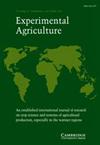芒果果实品质在采前和采后连续体上对管理因素的响应变化
IF 1.9
4区 农林科学
Q1 Agricultural and Biological Sciences
引用次数: 0
摘要
水果质量是一个关键因素——从生产者开始,持续到供应链,最后到消费者。它由多个指标描述,并在果实的生长和成熟过程中变化。本研究主要研究了芒果品质的两个主要方面:(i)果实的物理特性,包括鲜质量(FM)、果肉干物质含量(DMC)和果肉颜色;(二)化学性质与纸浆含糖量和纸浆酸度的关系。从开花后约60天至果实完全成熟,对这些指标进行了监测。同样的指标也监测了在冷库中储存的水果在成熟过程中的情况。评价了叶果比(可通过剪枝或疏枝管理)、果实成熟期(可通过采收日期管理)和贮藏温度对树上和贮藏果实品质性状动力学的影响。此外,采用变化点分析方法对甜度指数动力学(作为果实成熟的代表)进行了研究,以研究果实的成熟诱导。叶果比对果实生长的影响主要体现在FM和果肉DMC上,而对果实化学性质的演化影响较小。果实采收时的成熟期是决定成熟期潜在品质的关键因素。成熟自然发生在成熟的绿色阶段的树上果实,但成熟在较早的阶段可以通过收获果实诱导。在成熟阶段,较低的叶果比和冷藏温度往往会减缓甜度的日增长速度。在贮藏过程中使用低温减缓了淀粉的降解和蔗糖的积累,同时几乎停止了水果颜色和酸度的变化。本文章由计算机程序翻译,如有差异,请以英文原文为准。
Variations in mango fruit quality in response to management factors on a pre- and post-harvest continuum
Summary Fruit quality is a key factor – beginning with the producer, continuing through the supply chain, and ending with the consumer. It is described by multiple indicators and varies during the growth and ripening of the fruit. This study focused on two main aspects of Cogshall mango ( Mangifera indica L.) quality: (i) the physical properties of the fruit with fresh mass (FM), pulp dry matter content (DMC), and pulp coloration; and (ii) the chemical properties with pulp sugar content and pulp acidity. These indicators were monitored on on-tree fruit, from about 60 days after bloom until full maturity. The same indicators were also monitored on fruit stored in cold storage rooms during ripening. The effects of leaf-to-fruit ratio (manageable by pruning or fruit thinning), maturity stage of fruit at harvest (manageable by harvest date), and storage temperature on the kinetics of quality traits of on-tree and stored fruit were assessed. In addition, a change-point analysis was applied to the sweetness index kinetics (used as a proxy of fruit ripening) to study fruit ripening induction. The leaf-to-fruit ratio mainly influenced fruit growth in terms of FM and pulp DMC, whereas it had less impact on the evolution of fruit chemical properties. The maturity stage of the fruit at harvest was a key factor in determining the potential quality at the ripe stage. Ripening occurs naturally at the mature green stage for on-tree fruit, but ripening at an earlier stage can be induced by harvesting the fruit. During the ripening phase, a low leaf-to-fruit ratio and a cold storage temperature tended to slow down the daily rate of sweetness increase. The use of cold temperatures during storage slowed down starch degradation and sucrose accumulation, while almost stopping the variation in fruit coloration and acidity.
求助全文
通过发布文献求助,成功后即可免费获取论文全文。
去求助
来源期刊

Experimental Agriculture
农林科学-农艺学
CiteScore
2.50
自引率
6.20%
发文量
29
审稿时长
24 months
期刊介绍:
With a focus on the tropical and sub-tropical regions of the world, Experimental Agriculture publishes the results of original research on field, plantation and herbage crops grown for food or feed, or for industrial purposes, and on farming systems, including livestock and people. It reports experimental work designed to explain how crops respond to the environment in biological and physical terms, and on the social and economic issues that may influence the uptake of the results of research by policy makers and farmers, including the role of institutions and partnerships in delivering impact. The journal also publishes accounts and critical discussions of new quantitative and qualitative methods in agricultural and ecosystems research, and of contemporary issues arising in countries where agricultural production needs to develop rapidly. There is a regular book review section and occasional, often invited, reviews of research.
 求助内容:
求助内容: 应助结果提醒方式:
应助结果提醒方式:


